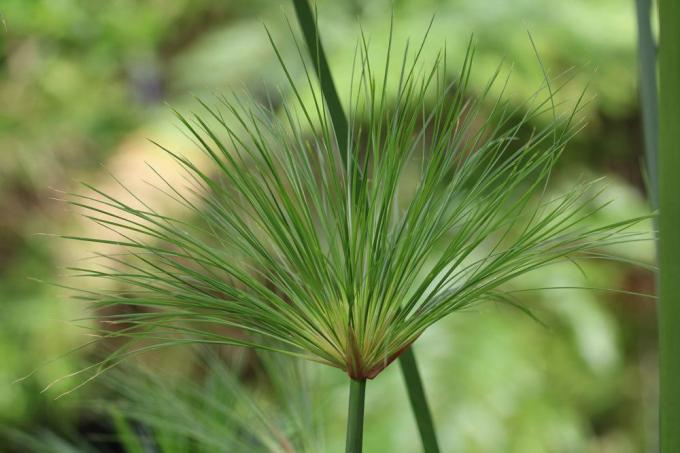
table of contents
- Location
- floor
- care
- to water
- Fertilize
- Cut
- Multiplication
- Special species
- Diseases
Profile and care information open +conclude -
- Flower color
- white, green, brown
- Location
- Sunny, full sun
- Heyday
- July August September
- Growth habit
- upright, bushy, perennial, perennial
- height
- up to 300 centimeters high
- Soil type
- sandy, loamy, gritty
- Soil moisture
- very damp, wet
- PH value
- angry
- Limescale tolerance
- Calcium tolerant
- humus
- k. A.
- Poisonous
- no
- Plant families
- Sourgrass family, Cyperaceae
- Plant species
- Ornamental grasses, marsh plants, Pond plants, Aquatic plants
- Garden style
- Water garden, ornamental garden
In ancient times, the real papyrus was of great importance in paper production. After being almost forgotten since then, it is now experiencing a renaissance as an idyllic indoor or garden plant. However, since the papyrus plant reacts very sensitively to mistakes in care, it is important to you a little more Pay attention to and understand a few basic needs of the universal talent to know. We have compiled them for you.
Location
The natural occurrences of the papyrus plant are mainly in warm regions with high soil moisture. The plant is found wild on the banks of rivers (such as the Nile), Southwest Asia and Florida. However, it is now threatened with extinction due to increasing siltation. The sour grass loves sunny to full sun locations and warm temperatures all year round.
- Light requirement: sunny
- high humidity
- moist soil
- also tolerates extreme heat
- Minimum temperature: 15 degrees
- optimal temperature in summer: 20 - 30 degrees
- sheltered from the wind
- not hardy
- small varieties as houseplant
- May on the terrace or balcony in summer
- also like Bank planting for the garden pond (Shallow water zone)
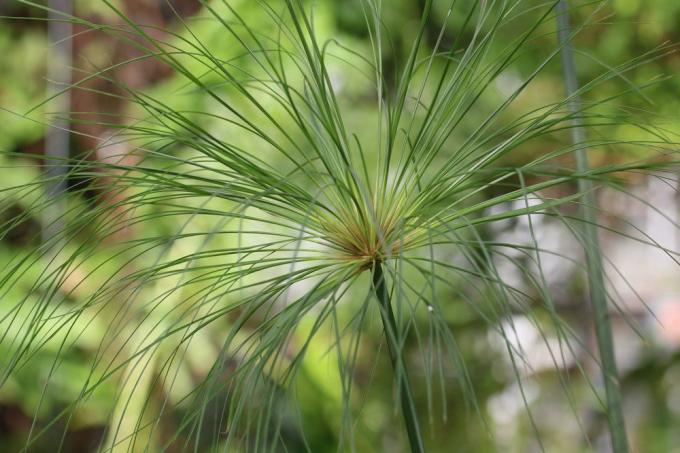
In its homeland, the grass grows up to three meters high. However, Cyperus papyrus does not reach this stately size in the apartment. Sedge grass, so-called false papyrus, is also often offered as a houseplant, but it differs slightly from real papyrus in terms of care. For example, the sedge (Cyperus alternifolius) tolerates slightly lower temperatures.
floor
For the healthy and vigorous growth of the papyrus bush, optimal soil conditions are an important cornerstone. The substrate differs depending on whether the plant is planted in the garden pond in the summer months or cultivated in a tub all year round.
- low in lime
- acidic pH range
- well permeable to water and air
- Pond culture: pure gravel and sand, possibly a small amount of compost
- Bucket culture: mixture of compost soil and sand
- alternatively: potting soil, compost and some clay
plants
As a rule, real papyrus is not planted in our garden due to its lack of tolerance to the cold, but rather cultivated in a tub. As soon as the temperatures rise permanently above 15 degrees in spring, the African ornamental plant can move to the field. Planting in the house is possible all year round. Sourgrass is allowed in the garden pond from mid-May at the earliest, and depending on the weather, not until the beginning of June.
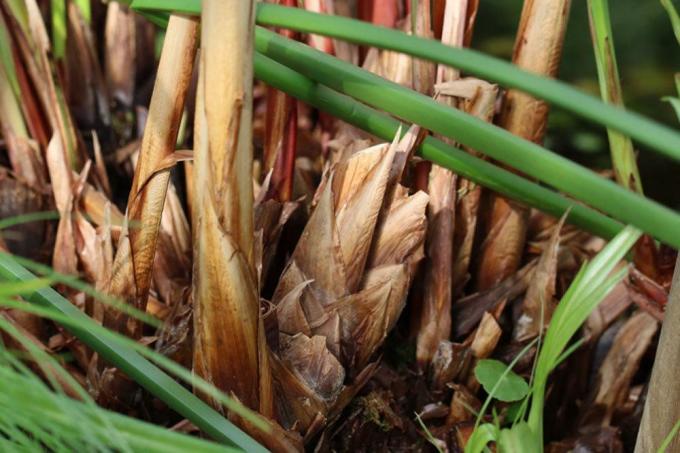
care
Maintenance in the garden pond
Since the papyrus is not hardy, it is best to place the marsh plant in a large plant basket, which can be moved into a large container in winter. In the garden pond, the plant feels at home in the shallow water zone. Here it is supplied with nutrients and water in sufficient quantities, so that almost no other maintenance measures are necessary during the stay in the field.
The warm and humid environment on the banks offers the Cyperus papyrus optimal growth conditions. Only check the water level during long periods of heat, because if the roots fall dry, the plant will react immediately and develop brown tips on the shoots.
to water
Cyperus papyrus feels at home wherever its roots are permanently damp to wet. The ornamental grass thirsts for water and can easily tolerate stagnant water in the root area. Drought, on the other hand, means the certain death of the vigorous plant. Those who take this into account have already covered a large part of the care needs.
- perfect as a bank planting of a large garden pond
- Use lime-free rainwater for watering
- The root ball must be permanently moist to wet
- Standing water must not reach the round stalks
- Fill the planter up to a third with water
Before the next watering, the irrigation water should either be completely absorbed or evaporated. This watering technique is very important so that the plant can absorb enough oxygen. Never let the root ball dry out, instead fill the saucer regularly with water.
Fertilize
In nature, the water's ecosystem takes over the water and nutrient balance of the imposing plant. If the papyrus is cultivated in a large planter, the gardener has to take on this task.
- only fertilize very cautiously
- Apply some liquid fertilizer once a month over the irrigation water
- do not use blue grain or horn shavings
Planters
So that the soil of the papyrus plant remains sufficiently moist, the use of a generous one is recommended Planter or, alternatively, a tall saucer that is filled with water at regular intervals have to. Do not choose the cachepot that is too small, otherwise it will be difficult to control and it will also be difficult to take care of it of the roots with oxygen is not guaranteed, so that root rot can occur in cramped pots can.
- large planter
- alternatively high coaster
- must be very stable (heights up to 3 m)
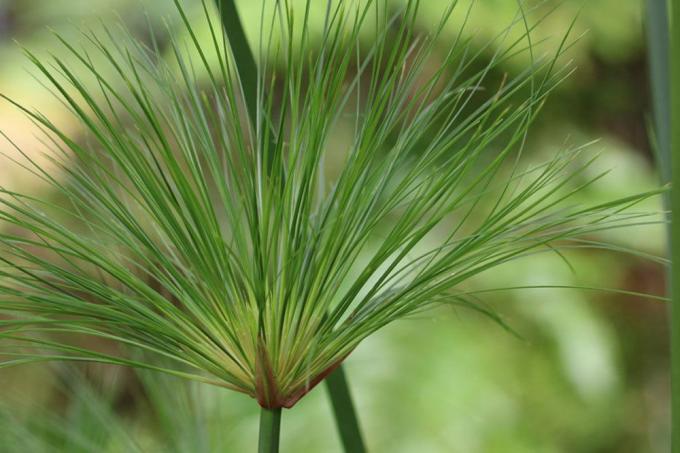
Hydroponics
A good way to provide the enormous water requirement and the high humidity for the papyrus plant is cultivation in hydroponics. Instead of organic substrate, clayey, mineral material is filled into the planter. This can be, for example, perlite, expanded clay or other porous stones.
Before you can hydropot plants that have previously been grown in normal soil, a little preparation is necessary. So it is essential to remove all substrate from the roots.
- Get the root ball out of the plant pot
- Place loose root balls in a bucket of water for several days
- Change the water every day and remove the washed-out soil
- then wash off under running water
- cut off damaged and rotten roots
- use special hydroponic vessels with a float
- fill in a layer of mineral substrate
- Insert the plant
- fill up with hydroponic stones
Fill the planter with lukewarm water until the water level indicator is at maximum. Also make sure that there is sufficient nutrient supply through a special hydroponic fertilizer.
Cut
Regular or targeted pruning is not necessary with the Cyperus papyrus. It is completely sufficient to cut off dead leaves and flower stalks about 10 cm above ground level. This measure stimulates the formation of new shoots and ensures a fresh, lush green appearance.
Repot
Since sedge plants grow very quickly under optimal conditions, the gardener should use the time before putting them outdoors again and repot the papyrus tree. This is best done in early spring, before the plant has sprouted again. If the previous pot is already completely penetrated by the roots, the marsh plant needs a larger vessel.
- Repot at least once a year
- Remove the plant very carefully from the old container
- to do this, grab several stalks at the base
- a second person is required for large plants
- if necessary, increase or reduce the size
- Create drainage (gravel, expanded clay, pottery shards)
- Put in fresh substrate
- water well
Although the papyrus plant is not poisonous, it is advisable to wear gloves and clothing that cover the arms and legs. The stalks of the African grass are very sharp and quickly cut deep wounds into the skin.
Overwinter
A papyrus must never overwinter with us outdoors, because the warmth-loving plant does not survive that. Since it cannot tolerate temperatures below 15 degrees, depending on the weather conditions, it has to be moved to its warm winter quarters as early as the beginning of September.
If possible, do not place the sour grass in the well-heated living room, because the air is too dry there and the plant gets brown tips. A winter garden would of course be perfect, but this is not absolutely necessary. On the other hand, Cyperus papyrus feels at home in a bright bathroom or a cooler bedroom.
- choose a bright and warm location
- not right next to the heater
- Temperature: 15-20 degrees
- ensure sufficient humidity
- yellow leaves indicate drought
- water regularly
Multiplication
Propagating is not necessarily difficult. Therefore, this challenge can also be mastered well by beginners. The only thing you need for this is a healthy and strong papyrus plant.
share
Cyperus papyrus reproduces itself through offshoots, so-called rhizomes, which are root runners that spread below the soil level. New shoots and roots form at vegetation points on the offshoot. From a certain size, these young plants are able to survive on their own, i.e. without any connection to the mother plant. They can therefore easily be separated from the papyrus plant.
- divide when repotting
- Time: spring
- carefully pull the root ball apart
- Shake out the earth a little
- cut with a sharp, clean knife
- an ax may be necessary for old plants
- Depending on the size, divide the root ball into two or three pieces
- each piece must contain several stalks and its own roots
- Fill drainage into a clean pot
- Insert the plant
- fill up with substrate
- water well
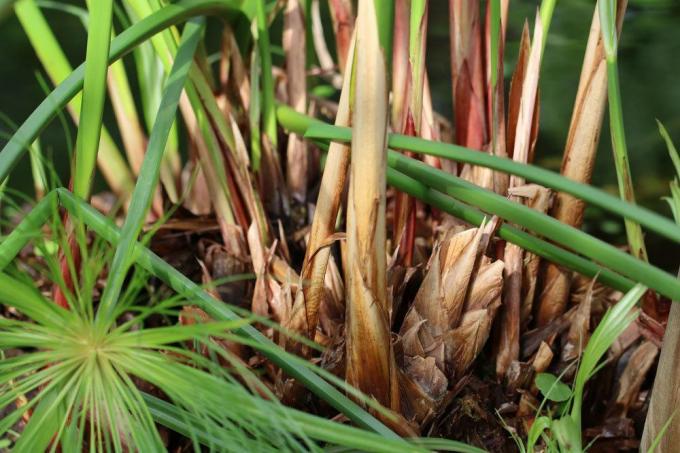
Cuttings
On the other hand, propagating the papyrus by cuttings is somewhat more demanding. In contrast to the false papyrus, for which this method works very reliably, the variant with the real papyrus has only a small chance of success. It is still worth a try.
- Time: summer
- Cut the stalks about 5 cm below the petals
- cut the bracts to about half
- Put your head upside down in moist potting soil
- Planting depth: about 2 cm
- Substrate: potting soil, mixture of peat and sand
- alternatively put in a glass with water
After successful rooting, which can take several weeks, plant the cuttings in flower pots.
Seeds
A somewhat time-consuming, but nevertheless promising way of propagating the real papyrus is to sow the fine seeds that form in the flowers on the long stalks.
- Time: in the apartment all year round
- Sprinkle seeds only on substrate
- do not cover with soil
- Substrate: potting soil, cactus soil
- Always keep the substrate moist
- only pour from below
- Protect the planter from evaporation with a plastic bag
- alternatively use a greenhouse
- Location: bright (without direct sun)
- Germination temperature: 25-28 degrees
- Germination time: about 30 days
- occasionally ventilate to prevent mold
After the first seedlings appear, the papyrus plant grows very quickly, provided that the temperature, water balance and light exposure are right. From a size of about three centimeters, the young plants can be isolated and cared for like a full-grown papyrus plant.
Delicacy for cats
Don't be surprised if your cats are having a hard time stopping nibbling on the fresh papers. Papyrus plants are a magical attraction for cats. Don't worry about your pet, the grass is not poisonous. In this case, the papyrus is more at risk.
Special species
In addition to the very expansive papyrus tree, specialist shops also offer lower forms. These varieties are recommended for pure indoor culture or all gardens with little space.
Little Giant Papyrus (Cyperus papyrus Dwarf Form)
- Height: up to 1 m
- also tolerates higher water levels (up to 30 cm)
- easier to cultivate than the original form
Diseases
Diseases and Pests
Diseases of the robust plant are rather rare, but root rot can occur if the irrigation water is too high. The papyrus plant is particularly susceptible to spider mites in its winter quarters, especially if the plant is next to the heater. If the ornamental grass is infested, wash it off in the shower and increase the humidity.
This is very easy by placing all of the ornamental grass in a clear plastic bag for several days and tying it. The plant itself survives this measure without any problems, the spider mites, on the other hand, do not like high humidity and disappear or die.
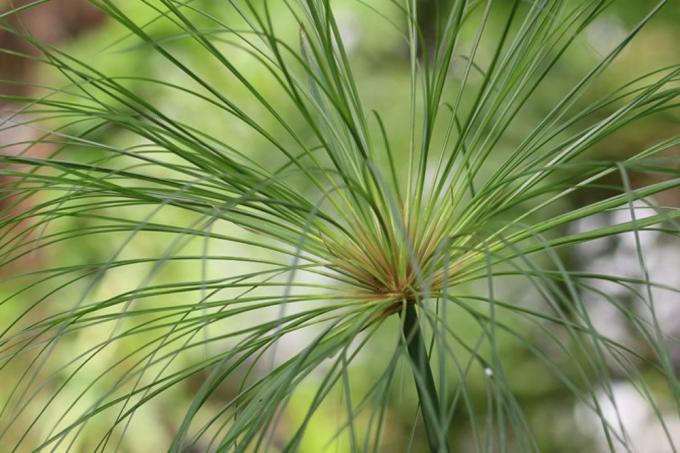
Care errors
Usually it is different mistakes in the care that weaken a Cyperus papyrus and cause it to die. The first signs of this are brown tips on the leaves.
Lack of water
If the leaves of the papyrus plant suddenly get brown tips, a lack of water is usually to blame. In this case, the water level in the bucket should be checked urgently. If the substrate is not dripping wet, it must be poured immediately. But don't overdo it and flood the whole bucket.
The plant doesn't like it when its stalks get wet. Therefore, a maximum of one third of the roots should be in the water. In addition, spray the plant every second or third day with low-lime water. You can cut off dried up stalks or brown tips with a sharp knife or scissors until just before the green area.
Root rot
If the papyrus plant is permanently in stale water with the entire root ball, there is a risk of root rot. The substrate and the roots of the Cyperus papyrus begin to die off due to a lack of oxygen. Immediately remove the plant from the water and let it drain well first. Then all soft roots are carefully cut with a sterile knife down to the healthy tissue.
Remove as much of the old substrate as possible and plant the papyrus in fresh soil and a clean pot. From now on, the plant will only be watered again when a large part of the previous irrigation water has already been used. Discard the old water and let the roots dry for about 15 minutes before filling the pot one-third with water again.



